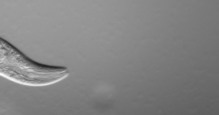397
 |
| Image credit: itimes.com |
Imagine a life where you could eat all the sweets, chocolates and junk food in the world and not bother about putting on weight. Well, it is not some weight loss diet or a strict exercise regime that we are promoting. This is you leading your normal life, going to work, lazying on weekends, spending time with your family and friends, but with one additional mutation inducted in your Nrf2 gene.
While this is far from reality for humans, at least in the near future, roundworms in Dr. Sean Curran‘s lab at the University of Southern California are enjoying this life style even today right now even as you read this post. This happening because the roundworms (Caenorhabditis elegans) carry a mutated version of the SKN-1 gene, which makes it hyperactive. The excess activity of the gene allows the worms to eat a high sugar diet and still not gain any weight while regular worms that do not carry the mutation became obese on a similar diet.
| Crawling C. elegans hermaphrodite worm (Photo credit: Wikipedia) |
Humans possess the Nrf2 gene which is similar in nature and function to the SKN-1 gene and therefore, Dr. Curran is confident that his findings will eventually be effective in humans as well. Luckily for him, the Nrf2 gene has been well characterized in humans and the Nrf2 protein produced by the gene is involved in the damage repair machinery of the cells. The gene has also been studied excessively, since increased activity of the gene has been linked with cancers.
Therefore, a genetic treatment for mitigating the effects caused by your sweet tooth might take a little longer to come in. Nevertheless, it is a start. But until the cure comes in, exercising should be a good resort you could take.
Source:
Pang, S., Lynn, D., Lo, J., Paek, J., & Curran, S. (2014). SKN-1 and Nrf2 couples proline catabolism with lipid metabolism during nutrient deprivation Nature Communications, 5 DOI: 10.1038/ncomms6048






